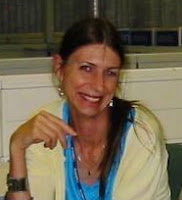Recipe for Winter Breakfast
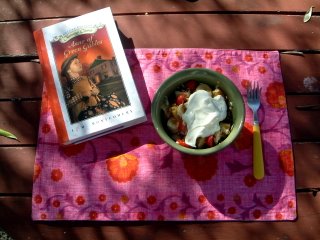 Ingredients: A sunny winter's morning;
Ingredients: A sunny winter's morning;
A garden seat and table...
...under an olive tree;
A deep green bowl of...
...banana, orange, strawberry,sunflower kernels, currants, fig,
granola and country-style yoghurt;
a fork (don't you eat muesli with a fork?);
Anne of Green Gables;
The company of a cat.
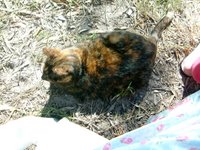
Flights of Fancy and Recollection
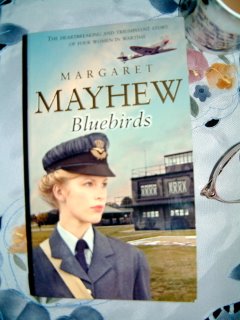 Just finished "Bluebirds" by Margeret Mayhew. Great book about the British Women's Auxiliary Airforce during World War 2. Couldn't put it down!I picked it up by chance (?) from a discount table at the local newsagents.It tells the story of an odd assortment of women of different ages and personalities from all walks and stations of life thrown together in the dark days of the Battle of Britain. Looked down upon by a misogynistic, male-dominated military, given scant equipment and poor conditions and pay and relegated to the most menial tasks, they nevertheless rose to the challenge and proved themselves a vital and indispensible part of the British war effort.The book is a very readable and enjoyable weaving together of personal drama, romance, action and historical detail. I loved it!The book had a special appeal for me. Quite apart from the fact that I also have done some military service and could personally relate to a number of aspects of military life related in the book, my maternal grandmother served in the Volounteer Observer Air Corps, a part-time civilian auxilliary force assigned to support the air defence of Australia. Many members of this force "manned" observation posts around the country to report on friendly and enemy air movements and their information was fed into the various air commands coordinating the defence. Others, however, served in the Fighter Sector Headquarters themslves, alongside regular RAAF and WAAAF personnel.Grandma was one of these and worked as a plotter in Number 1 FSHQ at Bankstown. This was set up initially in a cinema but then moved to an underground bunker (see below). Grandma's job was to plot the positions of aircraft on a large plotting table in response to commands from the controllers who were receiving information from observers and radar stations.My grandmother would get up early in the morning to see her two sons off to school and my grandfather off to De Havillands Aircraft factory (also at Bankstown) where he was engaged in making the Mosquito fighter bomber, which amazingly was built largely of plywood. Then she would go off to the bunker. That night she would be home cooking and serving dinner. Yep! Our fighting women, as always, served on two fronts!I can still remember sitting with her at her sunny kitchen bench having a cup of tea and her showing me her service brooch (nope! no uniforms for these heroines! just an insignia to pin to her jacket), her certificate of service and her khaki log book in which she proudly showed where she'd plotted the arrival of The Duke of Gloucester and Bob Hope! She pointed out the various aircraft types, Kittyhawks and Mitchells, and could still recite the Radio alphabet albeit the old World War 2 version: "Able, Baker, Charlie..."Three high points for her were the night she had to come home and sit down to tea with her family and not say a word about the shelling of Sydney by a Japanese submarine because she and the other staff had been sworn to secrecy; the visit of the Duke of Gloucester to her bunker where he shook her hand and spoke with her briefly and the time when one of the fighter pilots lifted her up to sit in the cockpit of his Spitfire.Sadly, I did not write all this down at the time and do not have her service memorabilia. I do hope that they are not lost and are safely in the keeping of my uncle or one of my cousins. I now have only these few scraps of memories.By a coincidence, although my mother dearly wished to serve in the Navy during World War 2 (but succumbed to her father's strong opposition) she also served briefly as a volounteer air spotter, searching the skies for Japanese aircraft over Braidwood (!) from the Church of England tower. Today one is tempted to snort, "As if...!" but in those dark, desperate days it must have seemed very real.
Just finished "Bluebirds" by Margeret Mayhew. Great book about the British Women's Auxiliary Airforce during World War 2. Couldn't put it down!I picked it up by chance (?) from a discount table at the local newsagents.It tells the story of an odd assortment of women of different ages and personalities from all walks and stations of life thrown together in the dark days of the Battle of Britain. Looked down upon by a misogynistic, male-dominated military, given scant equipment and poor conditions and pay and relegated to the most menial tasks, they nevertheless rose to the challenge and proved themselves a vital and indispensible part of the British war effort.The book is a very readable and enjoyable weaving together of personal drama, romance, action and historical detail. I loved it!The book had a special appeal for me. Quite apart from the fact that I also have done some military service and could personally relate to a number of aspects of military life related in the book, my maternal grandmother served in the Volounteer Observer Air Corps, a part-time civilian auxilliary force assigned to support the air defence of Australia. Many members of this force "manned" observation posts around the country to report on friendly and enemy air movements and their information was fed into the various air commands coordinating the defence. Others, however, served in the Fighter Sector Headquarters themslves, alongside regular RAAF and WAAAF personnel.Grandma was one of these and worked as a plotter in Number 1 FSHQ at Bankstown. This was set up initially in a cinema but then moved to an underground bunker (see below). Grandma's job was to plot the positions of aircraft on a large plotting table in response to commands from the controllers who were receiving information from observers and radar stations.My grandmother would get up early in the morning to see her two sons off to school and my grandfather off to De Havillands Aircraft factory (also at Bankstown) where he was engaged in making the Mosquito fighter bomber, which amazingly was built largely of plywood. Then she would go off to the bunker. That night she would be home cooking and serving dinner. Yep! Our fighting women, as always, served on two fronts!I can still remember sitting with her at her sunny kitchen bench having a cup of tea and her showing me her service brooch (nope! no uniforms for these heroines! just an insignia to pin to her jacket), her certificate of service and her khaki log book in which she proudly showed where she'd plotted the arrival of The Duke of Gloucester and Bob Hope! She pointed out the various aircraft types, Kittyhawks and Mitchells, and could still recite the Radio alphabet albeit the old World War 2 version: "Able, Baker, Charlie..."Three high points for her were the night she had to come home and sit down to tea with her family and not say a word about the shelling of Sydney by a Japanese submarine because she and the other staff had been sworn to secrecy; the visit of the Duke of Gloucester to her bunker where he shook her hand and spoke with her briefly and the time when one of the fighter pilots lifted her up to sit in the cockpit of his Spitfire.Sadly, I did not write all this down at the time and do not have her service memorabilia. I do hope that they are not lost and are safely in the keeping of my uncle or one of my cousins. I now have only these few scraps of memories.By a coincidence, although my mother dearly wished to serve in the Navy during World War 2 (but succumbed to her father's strong opposition) she also served briefly as a volounteer air spotter, searching the skies for Japanese aircraft over Braidwood (!) from the Church of England tower. Today one is tempted to snort, "As if...!" but in those dark, desperate days it must have seemed very real.
Although I served in the army as a male; women's military service always held a special, if secret, significance for me. I can still vividly remember, as a child, listening avidly to my mother's and grandmother's stories.I had the priviledge of serving in a unit which had a relatively high proportion of female soldiers. For all that I threw my heart and soul into my own duties I would often look wistfully at them, squadron clerking, radio-operating, truck driving, acting as enemy patrols and think, "There but for the unfortunate grace of God go I".But one soldiers on, doesn't one? And...often, by that very same grace of God, wins through!
My own military service gave me the strength and sense of self to undertake, finally, the difficult path to transition.
How hard it is to tell life's crosses from life's gifts? Each seems to have the extraordinary tendency to become the other.
As the Buddhists say, "The three poisons become the three seeds of virtue."!
I found this extraordinarily comprehensive website about Australia during World War 2 including information about and pictures of 1 FSHQ's bunker:
Peter Dunn's Australia@war (home page)
Australia@war - RAAF (1 FSHQ & the bunker)
I also found this account by a woman who served in the WAAAF in Fighter command HQ:
Australians at War
Hormones and Milestones
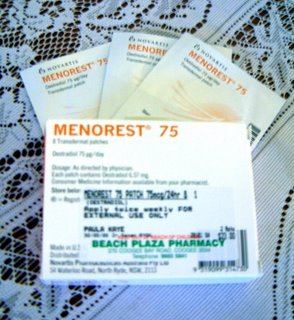 Went to see my endocrinologist, the "Prof", this morning. I've been going about every six months lately. The "Prof" is a remarkable man, well beyond retirement age but soldiering on. A real old-fashioned doctor, supplementing all the usual gamut of tests with his own rigorous observations and measurements; taking meticulous notes; a thorough gentleman. I believe he could be quite daunting if you weren't being honest...with him or with yourself; or if you weren't being sensible. But if you are those things, he's wonderfully professional, caring and supportive.He - along with the others in my health care "team" - has saved my life.Before my surgery he had me on weekly Primogyn depot injections supplemented by Depot Provera progestogen and Androcur anti-androgen. Since my surgery he's put me on twice weekly Menorest patches. We started out with the strongest dose, 100mcg then I tried 50mcg.I didn't feel right on either - on the stronger I found myself overly emotionally labile and prone to bouts of woolly-headedness and fatigue; on the lower dose I felt irritable and cranky and felt "hard" and "dry" and somehow subtly less feminine. Each time I see him, the "Prof" carries out extensive blood tests; he was concerned that on 50mcg my blood levels of estrogen were too low and carried too greater a risk of both osteoporosis and also a noticeable loss of femininity in my features. As a compromise, we tried the 75mcg patches.
Went to see my endocrinologist, the "Prof", this morning. I've been going about every six months lately. The "Prof" is a remarkable man, well beyond retirement age but soldiering on. A real old-fashioned doctor, supplementing all the usual gamut of tests with his own rigorous observations and measurements; taking meticulous notes; a thorough gentleman. I believe he could be quite daunting if you weren't being honest...with him or with yourself; or if you weren't being sensible. But if you are those things, he's wonderfully professional, caring and supportive.He - along with the others in my health care "team" - has saved my life.Before my surgery he had me on weekly Primogyn depot injections supplemented by Depot Provera progestogen and Androcur anti-androgen. Since my surgery he's put me on twice weekly Menorest patches. We started out with the strongest dose, 100mcg then I tried 50mcg.I didn't feel right on either - on the stronger I found myself overly emotionally labile and prone to bouts of woolly-headedness and fatigue; on the lower dose I felt irritable and cranky and felt "hard" and "dry" and somehow subtly less feminine. Each time I see him, the "Prof" carries out extensive blood tests; he was concerned that on 50mcg my blood levels of estrogen were too low and carried too greater a risk of both osteoporosis and also a noticeable loss of femininity in my features. As a compromise, we tried the 75mcg patches.
On those I felt well in myself; even-keeled yet "feminine". Don't ask me how, okay - it's sort of a feeling of being soft and round rather than like being a sharp dry stick! And yes I know this long streak of dishwater doesn't LOOK round - I said "FEEL", right?Well this morning, the "Prof" went over my results. I have estrogen levels equivalent to the high end of normal in post menopausal women not on HRT which is what we were aiming for - not abnormally high but neither too low. PSA levels, which give an indication of the risk of prostate cancer - yep! I've still got one of those! - were extremely negligible. That's the protective quality of estrogen there! However that very same level of estrogen exposes me to the same risk of breast cancer as any other woman of my age. Menorest has the advantage of not being being processed through the liver which makes it safer for a woman of my age. That's good because, having neither ovaries or testes I rely on hormone replacement therapy both for feminisation and lowering the risk of osteoporosis. These little patches and I are in for the long haul.I am aware that, being a 54 year old baby boomer, I'm part of that pioneering first wave of transsexual people entering middle and old age in significant numbers. We're an unknown quantity when it comes to all the medical, legal, social and political considerations of aging, retirement, superannuation, inheritance and dying.
Transsexualism is not something you take off, or grow out of or give up, it's you; a birth-mark going all way down to your core; the blood flowing in your veins; your being; your growing and your growing old; your living and your dying; your forever and always.The "Prof" closed his file. "Well, Paula, I think you're doing very well. I don't need to see you again, unless you feel you need to. So we'll leave it at that, 'appointment on request'". I thanked him and walked out into the bright cold sunshine of an early winter morning.I stood waiting for the lights to change, just as I'd stood there four and half years ago after my first visit to him. Clutching, my heart pounding, my first script for oestradiol. I'd gone into the first chemist I'd seen; got "on the train"; never looked back.
Now I was walking out after my last visit. Somehow, that was it, a milestone had been passed. There's still things I need to do; but I do them as the woman I am, living MY life, its highs and lows, its excitement and humdrum; its bright promise, its dark depths...an ordinary life at last.
Viewing Maningrida
 Last Wednesday night I attended the opening of "Maningrida", a photo exhibition by my dear friend and internationally-acclaimed photographer, Belinda Mason-Lovering."Maningrida" is named for the aboriginal community by that name in Arnhem Land in the Northern Territory. It tells the story in wonderful colour images of Charlie Djordila, the man, his family and his land. Charlie, a traditional Burarra man divides his time between his homelands, the township of Maningrida and the wider world of Australia. Charlie is senior lecturer at Maningrida Jobs, Employment & Training Centre.Outside it was a wet, cold Sydney winter night. My mary janes were sodden and my feet blocks of ice. Inside the Chrissie Cotter gallery in inner-city Camperdown it was all light and colour. Belinda was there with her boys and so were some friends and others I knew. I'd not been there long before the opening was launched by Lester, a local elder of the Sydney Cadigal people and Sam Byrne, the mayor of Marrickville. Lester, an urban man introduced Charlie, a traditional man.Armed with a glass of red to smooth the rough edges left after a long day's work I explored Belinda's images most of which I had never seen before. They were wonderful. The images she took of me in "Becoming Woman" were in black and white but these were in vivid colour. They had to be...the wide, deep, red earth, the high, wide, blue sky, the long, white sands of the coast, the deep, dark, blacks and browns of the people, the glistening silver of moonfish and the bright prints and patterns of clothing.I was entranced. How I wanted to be spirited high up into that high bright country, wider than the world, as clear as clear air, hearing the endless crash of the sea on the long shore and the cry of birds; feel the red earth and the white sand under my feet...far from the clatter and clutter of my corporate city strife...I mean life.Oh! I loved all the images! I can never go to one of Belinda's, exhibitions without being changed, challenged, unsettled, moved, transported, stretched.Now which did I love the most? Oh! It had to be the one of Charlie's daughter holding up two little silver moonfish like brooches. But I also loved the one of Charlie and his little son (see my photo of the invite above), the one of Charlie sitting down in the middle of the bush with his laptop and his little naked, wide-eyed son beside him, the one of the smoke of the bush fire on the horizon piling high up into the sky and joining with huge banks of cloud to form a high pillar in the sky; and the one of Charlie's wife cooking great-looking dampers over an open fire. Mmm! I loved them all!I felt an urge to do the groupie thing and talk to Charlie. He was in great demand so I hung on the rim of the acolytes. Eventually he noticed me and we spoke briefly. He explained each image and who was in it and its personal significance to him. We were both subjects...and friends of Belinda.
Last Wednesday night I attended the opening of "Maningrida", a photo exhibition by my dear friend and internationally-acclaimed photographer, Belinda Mason-Lovering."Maningrida" is named for the aboriginal community by that name in Arnhem Land in the Northern Territory. It tells the story in wonderful colour images of Charlie Djordila, the man, his family and his land. Charlie, a traditional Burarra man divides his time between his homelands, the township of Maningrida and the wider world of Australia. Charlie is senior lecturer at Maningrida Jobs, Employment & Training Centre.Outside it was a wet, cold Sydney winter night. My mary janes were sodden and my feet blocks of ice. Inside the Chrissie Cotter gallery in inner-city Camperdown it was all light and colour. Belinda was there with her boys and so were some friends and others I knew. I'd not been there long before the opening was launched by Lester, a local elder of the Sydney Cadigal people and Sam Byrne, the mayor of Marrickville. Lester, an urban man introduced Charlie, a traditional man.Armed with a glass of red to smooth the rough edges left after a long day's work I explored Belinda's images most of which I had never seen before. They were wonderful. The images she took of me in "Becoming Woman" were in black and white but these were in vivid colour. They had to be...the wide, deep, red earth, the high, wide, blue sky, the long, white sands of the coast, the deep, dark, blacks and browns of the people, the glistening silver of moonfish and the bright prints and patterns of clothing.I was entranced. How I wanted to be spirited high up into that high bright country, wider than the world, as clear as clear air, hearing the endless crash of the sea on the long shore and the cry of birds; feel the red earth and the white sand under my feet...far from the clatter and clutter of my corporate city strife...I mean life.Oh! I loved all the images! I can never go to one of Belinda's, exhibitions without being changed, challenged, unsettled, moved, transported, stretched.Now which did I love the most? Oh! It had to be the one of Charlie's daughter holding up two little silver moonfish like brooches. But I also loved the one of Charlie and his little son (see my photo of the invite above), the one of Charlie sitting down in the middle of the bush with his laptop and his little naked, wide-eyed son beside him, the one of the smoke of the bush fire on the horizon piling high up into the sky and joining with huge banks of cloud to form a high pillar in the sky; and the one of Charlie's wife cooking great-looking dampers over an open fire. Mmm! I loved them all!I felt an urge to do the groupie thing and talk to Charlie. He was in great demand so I hung on the rim of the acolytes. Eventually he noticed me and we spoke briefly. He explained each image and who was in it and its personal significance to him. We were both subjects...and friends of Belinda.
I had never spoken with a traditional aboriginal man before and, tho' I'm not sure about this, I think perhaps he had never spoken with a transsexual woman before. A first for both of us, maybe...I dunno.It wasn't long before he was whisked away though and after talking to some friends I bundled myself up underbrolly and sloshed down Parramatta road to catch a bus home.That night, lying, warm and snuggly in my princess bed, listening to the rain on the roof, I savoured the richness of friendship and meeting that has, so quite surprisingly, been bestowed upon me in these, my middle years, my second chance at life.And...I dreamed of Maningrida!
Marrickville Council press release about exhibitionManingrida Council websiteManingrida Art & Culture websiteBarani - an aboriginal history of Sydney
Intimate Encounters - Belinda's website
Blessings from Birds
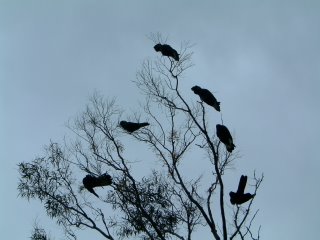 This morning we were roused from our routines by a raucous chorus high up in the gum trees at the back of the yard.Oh! blessings from birds!We had been visited by a flock of white-tailed black cockatoos.Our tree-groved back yard on its sandy hill overlooking Coogee beach is home to kookaburras, magpies, currawongs, crows and the sweetest little green parrots (I won't mention those nazi messerschmidts of the Australian backyard - Indian Mynahs) but this is the first time that I have seen black cockatoos.A magickal visitation!I took some photos and found a great web-link here.
This morning we were roused from our routines by a raucous chorus high up in the gum trees at the back of the yard.Oh! blessings from birds!We had been visited by a flock of white-tailed black cockatoos.Our tree-groved back yard on its sandy hill overlooking Coogee beach is home to kookaburras, magpies, currawongs, crows and the sweetest little green parrots (I won't mention those nazi messerschmidts of the Australian backyard - Indian Mynahs) but this is the first time that I have seen black cockatoos.A magickal visitation!I took some photos and found a great web-link here.
Braidwood Dreaming - revisiting
 Entry of Paula into Braidwood: Wallace Street
Entry of Paula into Braidwood: Wallace Street
looking South across Monkittee Creek
Recently I journeyed the 3 or 4 hours drive south of Sydney back to the small country town of Braidwood from which my mother's family comes and in which I spent every school holidays up until I was ten or twelve or so.
I went with Alex - mon amour, my sister and her eldest son. We drove down early Saturday morning and stayed overnight at a good, reasonably-priced local motel, "The Colonial", before returning to Sydney Sunday evening.
Braidwood is a heritage-listed town which is nestled in the Southern Tablelands of New South Wales between Canberra and the coast. The railway never having come to town, and the developers kept baying dolefully in the distance, its 19th century rural character has largely been retained unspoiled. Braidwood and the surrounding district is redolent with history from the early colonial, goldrush and bushranging times. During the 1970's the town was saved from a late twentieth century demise by a measured and respectful influx of tea houses, antique shops and art galleries.
Busloads of tourists supplemented truckloads of sheep and cattle!
Artists and bohemians arrived; the famous poet Judith Wright took up residence.
Braidwood looms large in my childhood memories. I grew up in the bustling, grimy inner suburbs of Sydney in the 50's as part of a complicated extended family mix of Scandinavian darkness and Irish sentimentality; working class circumstances blended with an intellectual and literary bent. So Christmas holidays in the country amongst rosy-faced, pragmatic country cousins under wide blue skies pierced with the cries of magpies was an extraordinary paradigm shift for me. One that made a wide and lasting impression.
Over the intervening 30 years I have made an occasional and infrequent return visit but always as an awkward and alien passer through. Slipping, diffidently, in and out, invisible as a shadow on a dark night.
Now for the first time since transition I made the return to Braidwood - the present and the past - as me as me, as Paula.
Transsexualism pre-transition most often means one experiences the world in a disengaged, alienated, behind-a-glass-wall way. Post-transition, the resulting psychological and physical integration lends experiences an immediacy, a cogency, an authenticity that quietly but deeply amazes, pleases and reassures the heart; heals the spirit.
It was the first time, since the relative uncomprehending innocence and guilelessness of childhood, that I - me - had been back. This time I was really there. And that little lost child I had been was there with me, striding along beside me, her own long legs keeping pace with mine.
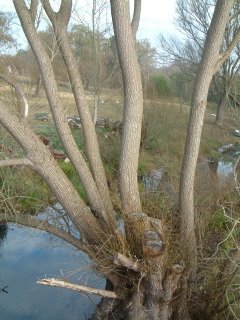 Monkittee Creek which flows along the northern
Monkittee Creek which flows along the northern
limits of the town at the back of my Nana's old
house in Solus St. The white shapes are geese.
That morning, as we hummed down the revamped, straightened-out, autobahn of the new Hume Highway towards the Southern Tablelands my mind drifted back to those foggy early morning long-hauls of years ago back in the fifties; our '48 Chevvy winding tortuously around the narrow gum-lined bends of the old road.
Now the little villages and towns are often bypassed by the new highway. There was something about motoring in the fifties that required frequent stops...to check the radiator or have a beer or do a wee behind a gum tree or perhaps it was something more arcane than that and now lost to the popular consciousness.
Now we just put the car into overdrive and keep going!
Arriving at Braidwood just before noon, we checked into the motel and then headed for a welcome caffeine fix at the Nambawan Coffeehaus (great coffee, to die for hot chocolate and amazing African wares for sale) and then, while I drove Alex around the back streets and showed him all the scenes from my childhood, my sister and nephew walked around town.
Later, we met up and drove up to the lookout on Mount Gillamatong, a high hill overlooking the town. Mount Gillamatong has an ancient, sacred feel to it. As a child I explored it's rocky, tree-covered slopes and dark, damp caves with my cousins during day-long escapades ("Famous Five on Gillamatong Mountain!"). It featured hauntingly, in a typical Australian, starkly beautiful way, in the film The Year my Voice Broke.
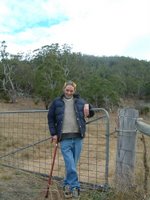
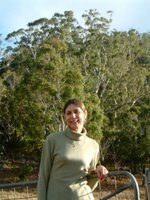
Alexx adopts a gentrified rural pose on Mount Gillamatong.
Paula revisits the scene of childhood ramblings.
From the foot of Mount Gillamatong one is treated to a sweeping view of the valley and the far blue hills and of Braidwood town, nestled like a storybook English village, with its church spires and sleepy tree-lined streets. The high, clear, cold air sings, soaring, the song of the Dreamtime - the land's dreaming and mine.
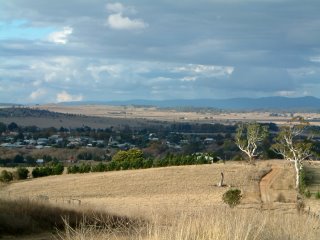 Autumn afternoon view of Braidwood and surrounding
Autumn afternoon view of Braidwood and surrounding
countryside from Mount Gillamatong Lookout
My nephew, Josh, is a keen movie buff and is studying film at TAFE so Braidwood was a rich mine of movie lore for him, several films having been made there over the years including Ned Kelly (1970 with Mick Jagger) and the afore-mentioned "The Year My Voice Broke" (1987 with Noah Taylor).
Later that evening, while Alex and Josh had a nap, my sister, Rowena and I went for a recce to find somewhere to have dinner. I just had to stop off at the bakery and buy a Braidwood Tin Loaf - the biggest high-domed loaf of delicious soft white country bread you'll ever find. When I was little we'd arrive at my Nana's to find the open fire burning in her big lining-boarded kitchen and fresh buttery tin loaf toast starting to pile up in the middle of the scrubbed deal table. I would have been content then, I think, to do nothing else with my life but to sit at that table eating that toast! One with vegemite, the next with peanut butter, the next just plain...then start all over again!
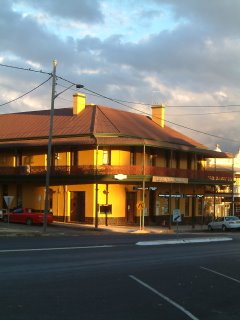 Historic Royal Mail Hotel caught
Historic Royal Mail Hotel caught
in an autumn evening's glow .
For dinner we settled on "Somewhere Special on Wallace". This absolutely great restaurant is situated in the old bakery and we sat out in the back room where the original ovens can still be seen. The fire was toasty, the food was delicious (I had Thai beef and Alex had spinach and fetta pie), the wine organic and the service very friendly. We all had a thoroughly good night. I recommend dining there if you're ever in Braidwood.
After a wintry night snuggled tightly up to Alex and with the electric blanket left on I rose early on Sunday and strode out into a clear crisp morning air and the warbling of magpies to crunch the gravel roadsides where I'd roamed as a child.
First stop was my Nana's old house at Solus Street just across the road (it was Poppa's house too but he seemed large and aloof and intimidating to me as a child - I think men often were in the fifties). Strange to think that it was now someone else's house! Then I was inside, snuggled up under the patchwork quilt or huddled in front of the open fire toasting toast on the toasting fork; now I could only look shyly from the footpath.
The house is basically the same on the outside but the wonderful world out the back of truck sheds and woodsheds and water tank cubby houses and jungles of overgrown fennel in which my cousins and I played endlessly were long gone. I could still smell it all though - in the deep recesses of my neurons - the woodchips in the tumbledown woodshed on a rainy day and the cold concrete floor of the austere outside bathroom and the soap and starch of the brick-copper laundry and the gunmetal of the shotguns in the office and the prickly bales of hay and the truck grease and hessian bags and diesel in the sheds and the road dust and the fennel. The fennel, pungent n' green n' yeller, taller by far than a tall child's tussled head!
 My sister, Ro, outside Nana's old house in
My sister, Ro, outside Nana's old house in
Solus Street
I had the digital camera in my handbag and captured scenes: some from my childhood, some new. I was feeling excitement in my waters (as Kath of Kath & Kim fame would say). Somehow I was making a connection with the child I'd been; somehow, unexpectedly, something more than just a weekend visit to a country town was unfolding.
I'll talk more of that in a later blog.
Up to "The Pines" on Glenmore Road I strode, down to the old swimming hole on Monkittee Creek (pronounced "Munketty" according to Mum but I like to say "Mon Kitty"), past the old flour mills on Mackellar St (unchanged since I was little), up Ryrie street past the little council flat my Nana moved into in her last years, along Coronation Ave where my auntie and uncle lived and where I spent much of my time playing as part of a horde of cousins and neighbourhood kids. Then back into the main street and past the Royal Cafe made famous in "The Year My Voice Broke" and the pressed-tin-walled picture theatre where we used to queue up on Saturdays to see black and white cowboy and Indian matinees in the fifties.
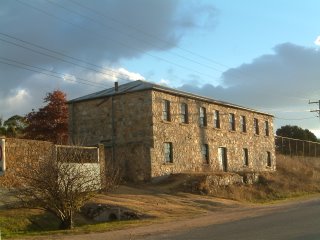 Old Flour Mills on MacKellar Street. I remember playing on the crumbling
Old Flour Mills on MacKellar Street. I remember playing on the crumbling
overgrown terrace out the front as a child. It seems just the same.
Finally past the old garage where I used to watch, amazed, as my very grown-up seeming country cousin (surely he was only ten or eleven years old?) used to help out serving petrol on Saturday afternoons. It's a Chinese restaurant now! Finally past the sculpture over the stile (yep! a real old English storybook-style stile) leading to Doctor Braidwood Wilson's grave up on a lonely hill beneath two trees. (he was the founder of Braidwood in the early nineteenth century).
Later that morning after a breakfast of tin loaf toast and motel coffee we visited the cemetery to say a prayer for Mum over the graves of her parents and sister. Just to break the illusion of being caught in a fifties time-warp I ended up being talked onto the location of my Auntie's grave by my Mum in Sydney giving me directions over my mobile phone! Afterwards we went to the Catholic Church, St Bede's, and took photos of the Bell Tower, which my father, an architect, designed in the sixties for the cathedral bell (which was originally an afterthought and too large for the church). I can still remember the little balsa wood architect's model with the silver Christmas tree bell he made sitting on our dining room table.
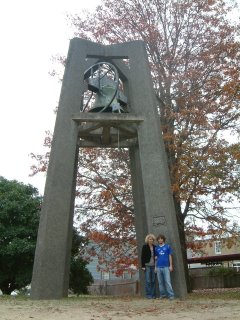 My sister and nephew under St Bede's bell
My sister and nephew under St Bede's bell
tower designed by our father in the sixties.
Our final stop before leaving town was at the Braidwood Museum which is housed in an 1840's era hotel. Fascinating place, rich with local history but, sadly, the museum shows the effects of underfunding and over-reliance on hard-working but under-resourced local volounteers.
 Braidwood Museum: Alex outside the old colonial
Braidwood Museum: Alex outside the old colonial
slab lock-up from the village of Mongarlowe
We are a nation that prefers to pander to multi-national developers and foreign imperialists than to build and tend our own communities and cultures. Look it's not my fault they bull-dozed that historic site...I didn't know! I was watching Shrek 2 on my new Samsung DVD! Ah! Yes! Fiddling with the remote control while Rome burns!
Well, emerging back out into the twenty-first century, jostling for a cubicle in the public toilets with Korean tourists and four wheel drivers we packed up and headed out of town. Back down the King's Highway to Goulburn (where my paternal grandfather ran a Ladies Hairdressing salon in the twenties and where our Dad grew up) where we had a coffee and toasted cheese and tomato sammidge at the iconic Paragon Cafe before the long drive back home to the the big smoke.
Paula's first Braidwood visit was over but already her mind was turning over plans for a return visit. Mmm! A vision quest on the slopes of Gillamatong and along the reaches of Monkittee Creek!
Stay chooned!
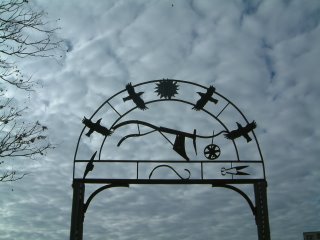 Symbol-rich sculpture over the entrance-way to the trail to
Symbol-rich sculpture over the entrance-way to the trail to
Doctor Braidwood Wilson's grave against the stippled autumn sky.
Braidwood Tourist Information site including map:
http://www.braidwood-tourism.com.au/
Southern Tablelands Tourist Information site (Braidwood pages):
http://www.argylecounty.com.au/towns/braidwood.html
Australian Community History online (Braidwood pages):
http://peoplesvoice.gov.au/stories/nsw/braidwood/braidwood_c.htm
You can get a good-resolution image of Braidwood on Google Earth:
http://earth.google.com/
(try tilting the map and "driving" down the road to the nearby goldrush village of Araluen!)


















